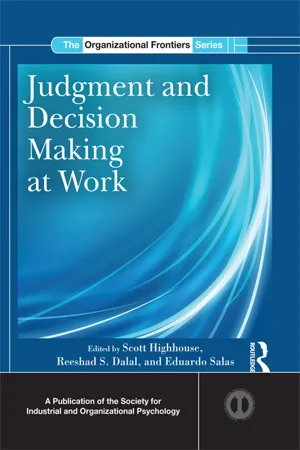
Judgment and Decision Making at Work
- 388 pages
- English
- ePUB (mobile friendly)
- Available on iOS & Android
Judgment and Decision Making at Work
About This Book
Employees are constantly making decisions and judgments that have the potential to affect themselves, their families, their work organizations, and on some occasion even the broader societies in which they live. A few examples include: deciding which job applicant to hire, setting a production goal, judging one's level of job satisfaction, deciding to steal from the cash register, agreeing to help organize the company's holiday party, forecasting corporate tax rates two years later, deciding to report a coworker for sexual harassment, and predicting the level of risk inherent in a new business venture. In other words, a great many topics of interest to organizational researchers ultimately reduce to decisions made by employees.
Yet, numerous entreaties notwithstanding, industrial and organizational psychologists typically have not incorporated a judgment and decision-making perspective in their research. The current book begins to remedy the situation by facilitating cross-pollination between the disciplines of organizational psychology and decision-making. The book describes both laboratory and more "naturalistic" field research on judgment and decision-making, and applies it to core topics of interest to industrial and organizational psychologists: performance appraisal, employee selection, individual differences, goals, leadership, teams, and stress, among others. The book also suggests ways in which industrial and organizational psychology research can benefit the discipline of judgment and decision-making. The authors of the chapters in this book conduct research at the intersection of organizational psychology and decision-making, and consequently are uniquely positioned to bridging the divide between the two disciplines.
Frequently asked questions
Important Milestones in the History of Judgment and Decision Making (JDM)
1950s | • Ward Edwards (1954) defines the domain of JDM in a classic 1954 Psychological Bulletin article |
• Paul Meehl (1954) publishes the classic Clinical Versus Statistical Prediction | |
• Kenneth Hammond (1955) applies Egon Brunswik’s lens model to clinical prediction | |
• Herbert Simon (1955) introduces the concept of “bounded rationality” | |
• Luce and Raiffa (1957) publish Games and Decisions | |
• Leon Festinger (1957) presents the theory of cognitive dissonance | |
1960s | • Ellsberg paradox (1961) stimulates interest in psychology of ambiguity |
• Allen Parducci (1966) introduces range-frequency theory | |
• James Stoner (1968) introduces the risky shift phenomenon (the initial impetus for the broader group polarization phenomenon) in group decision making | |
• Amos Tversky (1969) publishes “Intransitivity in preferences” | |
1970s | • Barry Staw (1976) introduces escalation of commitment |
• Janis and Mann (1977) publish Decision Making | |
• Kahneman and Tversky (1979) introduce prospect theory | |
• Robyn Dawes (1979) publishes the “The robust beauty of improper linear models” | |
1980s | • First JDM meeting is held in 1980 |
• Richard Thaler (1980) introduces mental accounting | |
• Nisbett and Ross (1980) publish Human Inference: Strategies & Shortcomings of Social Judgment | |
• Norman Anderson (1981) introduces information integration theory | |
• Kahneman, Slovic, and Tversky (1982) publish the classic Judgment Under Uncertainty: Heuristics and Biases | |
• Naylor (1985) changes the name of his journal to Organizational Behavior and Human Decision Processes | |
• Society for Judgment and Decision Making (SJDM; www.sjdm.org) is established in 1986 | |
• Calderwood, Crandall, and Klein (1987) define the field of naturalistic decision making | |
• Journal of Behavioral Decision Making introduced in 1988 | |
• Robyn Dawes (1988) publishes first edition of Rational Choice in an Uncertain World | |
1990s | • Gerd Gigerenzer (1991) challenges heuristics and biases paradigm |
• Max Bazerman (1991) publishes first edition of Judgment in Managerial Decision Making | |
• Tetlock (1991) introduces “people as politicians” perspective on JDM | |
• Shafir, Simonson, and Tversky (1993) introduce reason-based choice | |
• Klein, Orasanu, Calderwood, and Zsambok (1993) publish Decision Making in Action | |
• Scott and Bruce (1995) publish Decision-Making Style: The Development and Asse... |
Table of contents
- Cover Page
- Half Title Page
- The Organizational Frontiers Series
- SIOP Organizational Frontiers Series
- Title Page
- Copyright Page
- Dedication
- Contents
- Series Foreword
- About the Editors
- About the Contributors
- List of Abbreviations
- 1 Introduction to Judgment and Decision Making
- Part I Personnel Decision Making
- Part II Organizational Decision Making
- Part III Decision Making in Action
- Commentary
- Author Index
- Subject Index